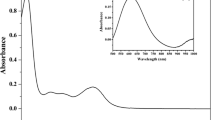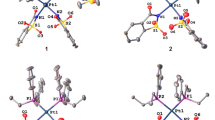Abstract
Two novel dinuclear platinum complexes, {trans-[Pt(NH3)2Cl]2(dpsu)}(NO3)2 (1) and {trans-[Pt(NH3)2Cl]2 (dpse)}(NO3)2 (2) (dpsu = 4,4′-dipyridyl sulfide and dpsu = 4,4′-dipyridyl selenide) have been prepared for use as potential antitumor drugs. Compared to the known monofunctional complex, [cis-Pt(NH3)2Cl(4-methylpyridine)]NO3, (1) exhibits an almost two-fold stronger DNA-binding ability, a result suggesting that (1) may bind bifunctionally to DNA. Kinetic studies show that (1) significantly impedes intercalation of ethidium bromide (EtdBr) into DNA in 0.3 mol dm−3 KNO3 but not in 0.3 mol dm−3 KCl, indicating that the hydrolysis is the first step upon addition of the complex to DNA. Also, the complex may interact with DNA by non-intercalation. Unlike its dinuclear analogs linked by aliphatic diamines, complex (1) does not induce a transition of poly(dG–dC) · poly(dG–dC) from the B form to the Z form. Moreover, complex (1) significantly inhibits the cleavage activity of BamHI endonuclease, but has no effect on that of EcoRI endonuclease. In contrast, its cis analog containing two [cis-Pt(NH3)2Cl]+ units greatly inhibits those of both BamHI and EcoRI, a result suggesting that the two isomers with the same aromatic ligand probably have different properties of DNA binding, and that (1) possibly shows higher DNA-binding selectivity than its cisanalog.
Similar content being viewed by others
References
N. Farrell, Comments Inorg. Chem., 16, 373 (1995).
L.S. Hollis, Platinum and Other Metal Coordination Compounds in Cancer Chemotherapy, in S.B. Howell (Ed), Plenum Press, New York, 1991, p. 115.
N. Farrell, Y. Qu, U. Bierbach, M. Valsecchi and E. Menta, B. Lippert (Ed), Cisplatin: Chemistry and Biochemistry of a Leading Anticancer Drug, Verlag-Basel, CH, 1999, p. 479.
N. Farrell, Y. Qu, L. Feng and B. Van Houten, Biochemistry, 29, 9522 (1990).
J.M. Pérez, M.A. Futertes, C. Alonso and C. Navarro-Ranninger, Crit. Rev. Oncol. Hematol., 35, 109 (2000).
L.R. Kelland, C.F.J. Barnard, K.J. Mellish, M. Jones, P.M. Goddard, M. Valenti, A. Bryant, B.A. Murrer and K.R. Harrap, Cancer Res., 54, 5618 (1994).
G.S. Baldew, C.A. Van Den Hamer, G. Los, N.E. Vermeulen, J.M. De Goeij and J. Gordon McVie, Cancer Res.,49, 3020 (1989).
K. El-Bayoumy, Y.Chae, P. Upadhyaya, C. Meachter, L.A. Cohen and B.S. Reddy, Cancer Res., 52, 2402 (1992).
A.S. Weisbergs, R. Heinle and B. Levine, J. Clin. Invest., 31, 217 (1952).
G. Zhao, H. Lin, S. Zhu, H. Sun and Y. Chen, Anti-cancer Drug Design, 13, 769 (1998).
G. Zhao, Ph.D. Thesis, Department of Chemistry, Nankai University, 1998.
G. Zhao, H. Lin, S. Zhu, H. Sun and Y. Chen, J. Coord. Chem., 46, 79 (1998).
B. Boduszek and J.S. Wieezorek, Monatshefte für Chemie, 111, 1111 (1980).
L.S. Hollis, A.R. Amundsen and E.W. Stern, J. Med. Chem., 32, 128 (1989).
G. Zhao, H. Lin, P.Yu, H. Sun, S. Zhu and Y. Chen, Chem. Biol. Interact., 116, 19 (1998).
Y. Qu and N. Farrell, Inorg. Chem., 31, 930 (1992).
N.S. Gill, R.H. Nuttal, D.E. Scaife and D.W. Sharp, J. Nuclear Inorg. Chem., 18, 79 (1961).
R. Bastida, A. De Blas, P. Castro, D.E. Fenton, A. Macias, R. Rial, A. Rodriguez and T. Rodriguez-Blas, J. Chem. Soc., Dalton Trans., 1493 (1996).
L.J. Butor and J.P. Macquet, Anal. Biochem., 89, 22 (1978).
J. Kasparkova, N. Farrell and V. Brabec, J. Biol. Chem., 275, 15789 (2000).
N. Farrell, T.G. Appleton, Y. Qu, J.D. Roberts, A.P.S. Fontes, K.A. Skov, P. Wu and Y. Zou, Biochemistry, 34, 15480 (1995).
R. Zaludova, A. Zakovska, J. Kasparkova, Z. Balcarova, V. Kleinwachter, O. Vrana, N. Farrell and V. Brabec, Eur. J. Biochem., 246, 508 (1997).
A. Johnson, Y. Qu, B. Van Houten and N. Farrell, Nucleic Acids Res., 20, 1697 (1992).
Author information
Authors and Affiliations
Rights and permissions
About this article
Cite this article
Zhao, G., Hu, X., Yu, P. et al. Synthesis and DNA-binding properties of binuclear platinum complexes with two trans-[Pt(NH3)2Cl]+ units bridged by 4,4′-dipyridyl sulfide or selenide. Transition Metal Chemistry 29, 607–612 (2004). https://doi.org/10.1007/s11243-004-1278-1
Issue Date:
DOI: https://doi.org/10.1007/s11243-004-1278-1




